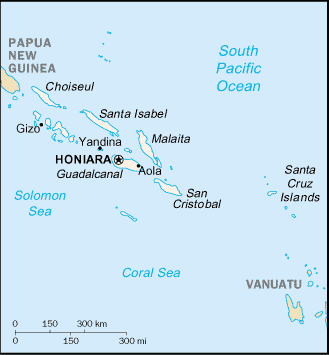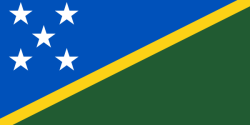Solomon Islands
Related Categories:
 Solomon Islands - Fotw
Solomon Islands - FotwDescription of flag, Civil Ensign, State Ensign, War Ensign, Governor-General's Flag, Unidentified Green Ensign, Historical Flags, Provincial Flags, Coat of Arms.
www.fotw.us/
The Solomon Islands is a nation in Melanesia, east of Papua New Guinea, consisting of nearly one thousand islands.
en.wikipedia.org/
People
The Solomon Islanders comprise diverse cultures, languages, and customs. Ninety-three percent are Melanesian, 4% Polynesian, and 1.5% Micronesian. In addition, small numbers of Europeans and Chinese are registered. About 120 vernacular languages are spoken.
Geography
The Solomon Islands form an archipelago in the Southwest Pacific about 1,900 kilometers (1,200 mi.) northeast of Australia. With terrain ranging from ruggedly mountainous islands to low-lying coral atolls, the Solomons stretch in a 1,450-kilometer (900 mi.) chain southeast from Papua New Guinea across the Coral Sea to Vanuatu.
The main islands of Choiseul, New Georgia, Santa Isabel, Guadalcanal, Malaita, and Makira have rainforested mountain ranges of mainly volcanic origin, deep narrow valleys, and coastal belts lined with coconut palms and ringed by reefs. The smaller islands are atolls and raised coral reefs, often spectacularly beautiful. The Solomon Islands region is geologically active, and earth tremors are frequent.
The islands' ocean-equatorial climate is extremely humid throughout the year, with a mean temperature of 27° C (80° F) and few extremes of temperature or weather. June through August is the cooler period. Though seasons are not pronounced, the northwesterly winds of November through April bring more frequent rainfall and occasional squalls or cyclones. The annual rainfall is about 305 centimeters (120 in.).
More than 90% of the islands traditionally was forested, but this has come under severe pressure from current logging operations. The coastal strips are sheltered by mangrove and coconut trees. Luxuriant rainforest covers the interiors of the large islands. Soil quality ranges from extremely rich volcanic to relatively infertile limestone. More than 230 varieties of orchids and other tropical flowers brighten the landscape.
www.state.gov/r/
Introduction
About
Contact
Symbols in The News
Interpret this Symbol
AAC
African
AI
Alchemy
Alphabets
Ancient
Animal Symbolism
Architecture
Art
Articles
Astrology
Baha'i
Blissymbolics
Blueprint Symbols
Buddhist
Celtic Symbols
Cemetery
Chinese Symbols
Christian
Circle
City
Codes
Color
Conlangs
Crop Circles
Danger
Da Vinci Code
Designing Logos
Dictionaries
Dreams
Education
Egyptian Symbols
Electrical
Emoticons
Find Images
Fonts
Food
Fraternity
Hamsa
Healing
Heraldry
Hermetic
Highway Signs
Hindu
History
Hobo
Holiday
Icons
iConji
Islamic
Jain Symbols
Japanese, Kanji
Jewish
Justice
Law
Literary Symbolism
Mandalas
Map
Masonic
Math, Number
Meaning of Names
Medical
Middle East
Military
Miscellaneous
Money
Music
Mythology
Native American
Playing Cards
Power
Psychology
QiQiiKhu
Reiki
Religious
Runes, Norse
Sacred Geometry
Scientific
Science Fiction
Sorority
Sports
Symbols in the News
Tattoos
ThirteenSymbols
Tree of Life
Ursprache
Videos
Visual Languages
Weather
Web Codes
Wicca
Words
Writing Systems
Braille
Coinherence
Coptic
Cuneiform
Easter Island
Etruscan
Happy Human
Hebrew
Kokopelli
Linear B
Lotus
Love Symbols
Mandorla
Moon Alphabet
Nine Pointed Star
Om
Oz
Phonetic
Scarab Beetle
Silent
Theosophy
Unifon
About
Contact
Symbols in The News
Interpret this Symbol
AAC
African
AI
Alchemy
Alphabets
Ancient
Animal Symbolism
Architecture
Art
Articles
Astrology
Baha'i
Blissymbolics
Blueprint Symbols
Buddhist
Celtic Symbols
Cemetery
Chinese Symbols
Christian
Circle
City
Codes
Color
Conlangs
Crop Circles
Danger
Da Vinci Code
Designing Logos
Dictionaries
Dreams
Education
Egyptian Symbols
Electrical
Emoticons
Find Images
Fonts
Food
Fraternity
Hamsa
Healing
Heraldry
Hermetic
Highway Signs
Hindu
History
Hobo
Holiday
Icons
iConji
Islamic
Jain Symbols
Japanese, Kanji
Jewish
Justice
Law
Literary Symbolism
Mandalas
Map
Masonic
Math, Number
Meaning of Names
Medical
Middle East
Military
Miscellaneous
Money
Music
Mythology
Native American
Playing Cards
Power
Psychology
QiQiiKhu
Reiki
Religious
Runes, Norse
Sacred Geometry
Scientific
Science Fiction
Sorority
Sports
Symbols in the News
Tattoos
ThirteenSymbols
Tree of Life
Ursprache
Videos
Visual Languages
Weather
Web Codes
Wicca
Words
Writing Systems
Braille
Coinherence
Coptic
Cuneiform
Easter Island
Etruscan
Happy Human
Hebrew
Kokopelli
Linear B
Lotus
Love Symbols
Mandorla
Moon Alphabet
Nine Pointed Star
Om
Oz
Phonetic
Scarab Beetle
Silent
Theosophy
Unifon

